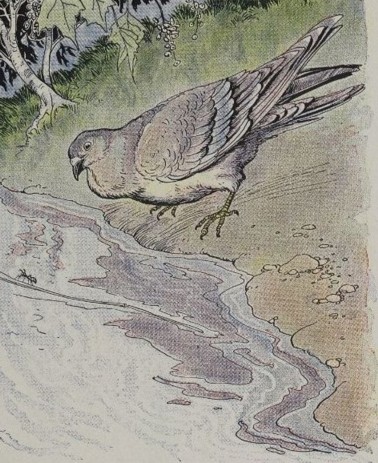PART A_1
Let’s learn vocabulary. Listen and repeat the words and the sentences with your tutor.
PART A_2
| 1. brook | /brook/ |
| -a small natural stream of fresh water | |
| There is a paper boat floating on the brook. | |
| 2. vein | /veyn/ |
| -producing no results; useless | |
| Do not spend this beautiful day in vain. | |
| 3. cling | /kling/ |
| -to be or remain close; to remain tight as if by embracing | |
| The baby was clinging to his mother. | |
| 4. cast | /kast/ |
| -to throw something | |
| I learned how to cast a fishing rod today. | |
| 5. spar | /spahr/ |
| -a thick, strong pole used for a yard on the ship | |
| I saw a ship’s spar in the museum today. |
PART B_1
Let’s read the story. Please read them aloud, and I will check your pronunciation and intonation.
PART B_2
The Ant and the Dove

A Dove saw an Ant fall into a brook. The Ant struggled in vain to reach the bank, and in pity, the Dove dropped a blade of straw close beside it.
Clinging to the straw like a shipwrecked sailor to a broken spar, the Ant floated safely to shore.
Soon after, the Ant saw a man getting ready to kill the Dove with a stone.
But just as he cast the stone, the Ant stung him in the heel
so that the pain made him miss his aim, and the startled Dove flew to safety in a distant wood.
Kindness is never wasted.
PART C_1
Let’s answer comprehension questions. Please answer them based on the story.
PART C_2
| 1. | Where did the Ant fall? |
| 2. | How did the Dove help the Ant? |
| 3. | What did the Ant do to the man? |
PART D_1
Let’s discuss the story. Please answer the questions below and express your opinions.
PART D_2
| 1. | Have you ever helped a friend in need? |
| 2. | How do you feel when someone is being kind to you? Please share. |
| 3. | How do you feel when someone is being unkind to you? |
| 4. | Do you agree with the fable’s lesson? Why or why not? |
| 5. | Do you think it is also important to be kind to animals? Why? |
REVIEW AND FEEDBACK
Now, let us review the things that you learned in this lesson.
ではこのレッスンで学んだことを振り返りましょう。
(Please give a short feedback on how your student did on your class.)
| Grammar 文法 |
Pronunciation 発音 | Vocabulary 単語 |
Comprehension 理解 |
|
|---|---|---|---|---|
 GOOD GOOD |
文法の誤りはほとんどなく、完全な文章で話すことができる | ほとんどの単語をはっきりと正しく発音することができる | 習った表現を適切に使うことができる | 文章を理解し、質問に正しく答えることができる |
 FAIR |
文法の誤りはあるが、完全な文章で話すことができる | 発音の練習が必要な言葉がいくつかある | たまにミスはあるが、習った表現を適切に使うことができる | 文章を完全に理解するのは難しく、質問に正しく答えられないときもある |
 POOR |
文章で話すのは難しく、単語だけで話すことができる | 発音の練習が必要である | 習った単語と表現を少しだけ使うことができる | 文章を理解するのは難しく、質問に答えるのは難しい |
Parts of this lesson material are based on:
An eBook from The Project Gutenberg.
This eBook is for the use of anyone anywhere at no cost and with almost no restrictions whatsoever. You may copy it, give it away or re-use it under the terms of the Project Gutenberg License included with this eBook or online at www.gutenberg.org
An eBook from The Project Gutenberg.
This eBook is for the use of anyone anywhere at no cost and with almost no restrictions whatsoever. You may copy it, give it away or re-use it under the terms of the Project Gutenberg License included with this eBook or online at www.gutenberg.org